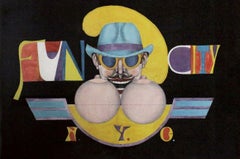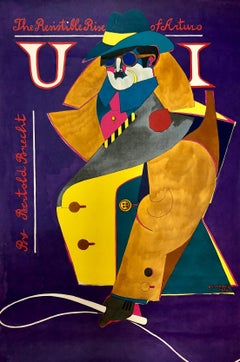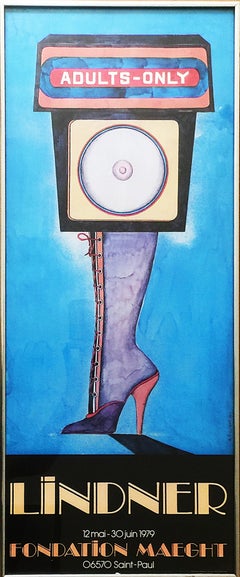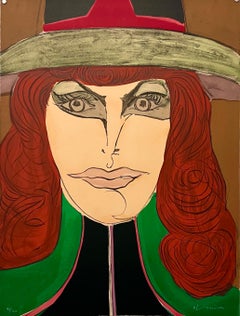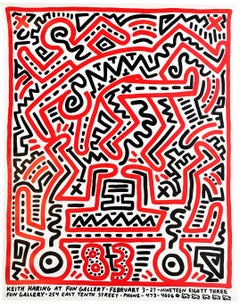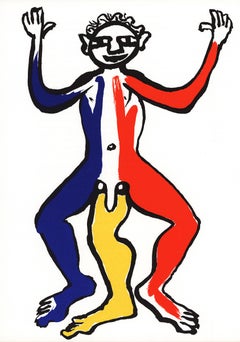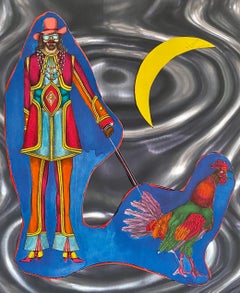Richard Lindner Abstract Prints
American, 1901-1978
Richard Lindner (1901 – 1978) was a German-American painter. Lindner's mother was owner of a custom-fitting corset business and Richard Lindner grew up and studied at the Kunstgewerbeschule (Arts and Crafts School since 1940 Academy of Fine Arts). From 1924 to 1927 he lived in Munich and studied there from 1925 at the Kunstakademie. In 1927 Lindner moved to Berlin and stayed there until 1928, when he returned to Munich to become art director of a publishing firm. He remained in Munich until 1933, when he was forced to flee to Paris. Once in Paris, Lindner became politically engaged, sought contact with French artists and earned his living as a commercial artist. He was interned when World War II broke out in 1939 and later served in the French Army. In 1941, Lindner moved to the United States and worked in New York City as an illustrator of books and magazines. There he made contact with New York artists and German emigrants such as Albert Einstein, Marlene Dietrich, and Saul Steinberg. In 1948, Lindner became an American citizen. Lindner taught at a number of institutions including the Pratt Institute, Brooklyn, Hochschule fur bildende Kunste in Hamburg and Yale University School of Art and Architecture. His paintings often used the sexual symbolism of advertising and investigated definitions of gender roles in the media.(Biography provided by ArtWise)
to
7
1
1
6
2
4
2
2
Overall Height
to
Overall Width
to
6
1
1
2
2
1
1
1
1
1
1
8
3
4
36
545
437
207
173
8
2
Artist: Richard Lindner
Original "Spoleto 1974, Lulu Opera' vintage poster
By Richard Lindner
Located in Spokane, WA
Original linen-backed 1974 Spoleto poster. Roman Polanski directed Alban Berg's opera LuLu at the Spoleto Festival, which was conducted by Christopher K...
Category
1970s Abstract Richard Lindner Abstract Prints
Materials
Lithograph
Vintage Modern Lithograph Poster 1960s Pop Art Mod Figure
By Richard Lindner
Located in Surfside, FL
Vintage 1960's Lithograph poster for Vancouver Canada art show.
Richard Lindner was born in Hamburg, Germany. In 1905 the family moved to Nuremberg, where Lindners mother was owner o...
Category
1960s Pop Art Richard Lindner Abstract Prints
Materials
Lithograph
Fun City, N.Y.C.
By Richard Lindner
Located in New York, NY
A very good impression of this color lithograph. Signed and numbered 125/175 in pencil, lower margin.
Category
1970s Pop Art Richard Lindner Abstract Prints
Materials
Color, Lithograph
Offset Lithograph Poster Resistible Rise of Arturo, Bertold Brecht 1968 Pop Art
By Richard Lindner
Located in Surfside, FL
Plate signed and dated, offset lithograph.
Richard Lindner was born in Hamburg, Germany. In 1905 the family moved to Nuremberg, where Lindners mother was owner of a custom-fitting co...
Category
1960s Pop Art Richard Lindner Abstract Prints
Materials
Lithograph, Offset
Adults-Only
By Richard Lindner
Located in New York, NY
Richard Lindner
Adults-Only, 1979
Offset lithograph poster
Plate signature with date, right front
Frame Included: held in vintage 1970s metal period frame
This is a rare vintage post...
Category
1970s Pop Art Richard Lindner Abstract Prints
Materials
Lithograph, Offset
1971 Modernist Lithograph Redhead Pop Art Mod Fashionable Woman Richard Lindner
By Richard Lindner
Located in Surfside, FL
RICHARD LINDNER (American. 1901-1978)
Hand Signed limited edition lithograph with blindstamp
Publisher: Shorewood-Bank Street Atelier for the Skowhegan School of Painting and Sculpture
29.25 X 22 inches
Richard Lindner was born in Hamburg, Germany. In 1905 the family moved to Nuremberg, where Lindner's mother was owner of a custom-fitting corset business and Richard Lindner grew up and studied at the Kunstgewerbeschule (Arts and Crafts School since 1940 Academy of Fine Arts). From 1924 to 1927 he lived in Munich and studied there from 1925 at the Kunstakademie. In 1927 he moved to Berlin and stayed there until 1928, when he returned to Munich to become art director of a publishing firm. He remained there until 1933, when he was forced to flee to Paris, where he became politically engaged, sought contact with French artists and earned his living as a commercial artist. He was interned when the war broke out in 1939 and later served in the French Army. In 1941 he went to the United States and worked in New York City as an illustrator of books and magazines (Vogue, Fortune and Harper's Bazaar). He began painting seriously in 1952, holding his first one-man exhibit in 1954. His style blends a mechanistic cubism with personal images and haunting symbolism. LIndner maintained contact with the emigre community including New York artists and German emigrants (Albert Einstein, Marlene Dietrich, Saul Steinberg). Though he became a United States citizen in 1948, Lindner considered himself a New Yorker, but not a true American. However, over the course of time, his continental circus women became New York City streetwalkers. New York police uniforms replaced European military uniforms as symbols of authority.At a time when Abstract Expressionism was all the rage, Lindner’s painting went against the current and always kept its distance. His pictorial language of vibrant colours and broad planes of colour and his urban themes make him a forerunner of American Pop Art. At the same time, he owes the critical tone of his paintings to the influence of European art movements such as Neue Sachlichkeit and Dada. His first exhibition did not take place until 1954, by which time he was over fifty, and, interestingly, it was held at the Betty Parsons Gallery in New York, a venue associated with the American Expressionists. From 1952 he taught at the Pratt Institute, Brooklyn, from 1967 at Yale University School of Art and Architecture, New Haven. In 1957 Lindner got the William and Norma Copley Foundation-Award. In 1965 he became Guest Professor at the Akademie für Bildende Künste, Hamburg. His Ice (1966, Whitney Museum of American Art) established a connection between the metaphysical tradition and pop art. He did work on Rowlux which was used by a number of pop artists (most notably Roy Lichtenstein)The painting shows harsh, flat geometric shapes framing an erotic but mechanical robot-woman. His paintings used the sexual symbolism of advertising and investigated definitions of gender roles in the media. While influencing Pop Art (Andy Warhol, Tom Wesselmann and Claes Oldenburg amongst others) his highly colourful, hard-edge style seems to have brought him close to Pop Art, which he rejected. Nevertheless, he is immortalised on the cover of the Beatles record "Sgt. Pepper’s Lonely Hearts Club Band" (1967) as a patron of the pop culture. He also did a tapestry banner with the Betsy Ross Flag...
Category
1970s Pop Art Richard Lindner Abstract Prints
Materials
Lithograph
Vintage Modern Lithograph Poster 1960s Pop Art Mod Figure Pencil Signed
By Richard Lindner
Located in Surfside, FL
Richard Lindner was born in Hamburg, Germany. In 1905 the family moved to Nuremberg, where Lindners mother was owner of a custom-fitting corset business and Richard Lindner grew up and studied at the Kunstgewerbeschule (Arts and Crafts School since 1940 Academy of Fine Arts). From 1924 to 1927 he lived in Munich and studied there from 1925 at the Kunstakademie. In 1927 he moved to Berlin and stayed there until 1928, when he returned to Munich to become art director of a publishing firm. He remained there until 1933, when he was forced to flee to Paris, where he became politically engaged, sought contact with French artists and earned his living as a commercial artist. He was interned when the war broke out in 1939 and later served in the French Army. In 1941 he went to the United States and worked in New York City as an illustrator of books and magazines (Vogue, Fortune and Harper's Bazaar). He began painting seriously in 1952, holding his first one-man exhibit in 1954. His style blends a mechanistic cubism with personal images and haunting symbolism. LIndner maintained contact with the emigre community including New York artists and German emigrants (Albert Einstein, Marlene Dietrich, Saul Steinberg). Though he became a United States citizen in 1948, Lindner considered himself a New Yorker, but not a true American. However, over the course of time, his continental circus women became New York City streetwalkers. New York police uniforms replaced European military uniforms as symbols of authority.At a time when Abstract Expressionism was all the rage, Lindner’s painting went against the current and always kept its distance. His pictorial language of vibrant colours and broad planes of colour and his urban themes make him a forerunner of American Pop Art. At the same time, he owes the critical tone of his paintings to the influence of European art movements such as Neue Sachlichkeit and Dada. His first exhibition did not take place until 1954, by which time he was over fifty, and, interestingly, it was held at the Betty Parsons Gallery in New York, a venue associated with the American Expressionists. From 1952 he taught at the Pratt Institute, Brooklyn, from 1967 at Yale University School of Art and Architecture, New Haven. In 1957 Lindner got the William and Norma Copley Foundation-Award. In 1965 he became Guest Professor at the Akademie für Bildende Künste, Hamburg. His Ice (1966, Whitney Museum of American Art) established a connection between the metaphysical tradition and pop art. The painting shows harsh, flat geometric shapes framing an erotic but mechanical robot-woman.His paintings used the sexual symbolism of advertising and investigated definitions of gender roles in the media. While influencing Pop Art (Tom Wesselman and Claes Oldenburg amongst others) his highly colourful, hard-edge style seems to have brought him close to Pop Art, which he rejected. Nevertheless, he is immortalised on the cover of the Beatles record...
Category
1960s Pop Art Richard Lindner Abstract Prints
Materials
Lithograph
1970's New York original lithograph by Richard Lindner
By Richard Lindner
Located in Petworth, West Sussex
A funky urban image from 1971 depicting some of the nuances of New York seedy underbelly. This original lithograph is number 73 of and edition of 75 from the 1971 'Fun City' suite. Originally there were 12 different artworks in this series by Richard Lindner of which this is the title piece.
Signed in pencil 'R Lindner...
Category
Late 20th Century Modern Richard Lindner Abstract Prints
Materials
Lithograph
Related Items
Keith Haring Fun Gallery exhibition poster 1983 (vintage Keith Haring)
By Keith Haring
Located in NEW YORK, NY
Keith Haring Fun Gallery 1983:
Original 1983 Keith Haring illustrated exhibition poster published on the occasion of Haring's historic 1983 show at the Fun Gallery in the East Village. A classic array of early Haring imagery that reveals red and black interlocking figures. A rare example in very good overall vintage condition.
Offset lithograph in colors on smooth wove paper.
23 x 29 inches.
Only some minor signs of handling; in otherwise very good overall vintage condition with strong colors; one of the better examples we've come across. Stored away from light; never mounted or framed.
Unsigned from an edition of unknown; scarce.
Catalog Raisonne:
Keith Haring: Posters (Prestel Publishing).
References:
Included in the collection of the Cooper Hewitt, Smithsonian Design Museum.
About the Fun Gallery:
Historic, short-lived, East Village gallery known for giving Keith Haring, Basquiat & Kenny Scharf some of their first solo shows.
“FUN Gallery was a place where neighborhood kids, downtown artists, b-boys, rock, film, and rap stars mixed with museum directors art historians and uptown collectors at wild openings featuring artists like Futura, Fab 5...
Category
1980s Pop Art Richard Lindner Abstract Prints
Materials
Lithograph, Offset
Vintage 1970s Alexander Calder lithograph (Calder three legged man)
By Alexander Calder
Located in NEW YORK, NY
Vintage original 1970s Alexander Calder Lithograph:
11x15 inches.
Very good overall vintage condition.
Unsigned from an edition of unknown.
Published by: Galerie Maeght, Paris, 19...
Category
1970s Pop Art Richard Lindner Abstract Prints
Materials
Lithograph
The Red Horsemen (aka Equestrians) Modern Art Pavilion Seattle Art Museum Poster
By Roy Lichtenstein
Located in New York, NY
Roy Lichtenstein at Modern Art Pavilion, Seattle Art Museum Limited Edition poster, 1976
Offset lithograph
Limited Edition of 1500
22 1/2 × 28 inches
Unframed
This limited edition o...
Category
1970s Pop Art Richard Lindner Abstract Prints
Materials
Lithograph, Offset
1970s Alexander Calder poster (Calder Braniff Airlines 1976)
By Alexander Calder
Located in NEW YORK, NY
Alexander Calder Braniff Airlines poster 1976:
Medium: Offset lithograph.
Dimensions: 23 x 33 inches.
An original 1st printing in very good ...
Category
1970s Pop Art Richard Lindner Abstract Prints
Materials
Lithograph, Offset
Keith Haring Paradise Garage Exhibit Poster 'Keith Haring Jeffrey Deitch'
By Keith Haring
Located in NEW YORK, NY
Rare vintage Keith Haring exhibition poster published on the occasion of:
‘Paradise Garage: Keith Haring and Music,
December 14, 2000-February 10, 2001, Deitch Projects, 18 Wooster ...
Category
1980s Pop Art Richard Lindner Abstract Prints
Materials
Paper, Lithograph, Offset
Milton Glaser The Lovin' Spoonful poster (Milton Glaser posters)
By Milton Glaser
Located in NEW YORK, NY
1970s Milton Glaser Poster Art:
Milton Glaser The Lovin' Spoonful: Vintage original Milton Glaser poster c.1972. Designed by Milton Glaser on the occasion of: "The Lovin' Spoonful a...
Category
1960s Pop Art Richard Lindner Abstract Prints
Materials
Lithograph, Offset
Abstract Expressionist, Art Brut Lithograph, 'A Day Out'.
Located in Cotignac, FR
Abstract Expressionist lithograph on BFK Rives paper of a late 20th century work by French artist Eliane Larus.
A lively and highly colourful lithograph...
Category
Late 20th Century Abstract Expressionist Richard Lindner Abstract Prints
Materials
Lithograph
La Perruch et la Sirene
By (after) Henri Matisse
Located in Washington, DC
Artist: Henri Matisse (after)
Title: La Perruch et la Sirene
Portfolio: The Last Works of Henri Matisse
Medium: Lithograph
Date: 1958
Edition: 2000
Sheet Siz...
Category
1950s Abstract Richard Lindner Abstract Prints
Materials
Lithograph
Danish exhibition poster for "Photographs by Jim Dine" (hand signed by Jim Dine)
By Jim Dine
Located in New York, NY
JIM DINE
This is How I Remember Now (Hand Signed), 2008
Offset Lithograph Poster for exhibition of photographs by Jim Dine
32 × 24 inches
Signed boldly in white marker by Jim Dine on the front
Unframed
Published by: Det Kongelige Bibliotek, Denmark
Provenance: Jim Dine personally signed it for the present owner in 2012 at a special poetry reading that the artist gave at the Dia Art Foundation.
Extremely rare when hand signed!
This poster was produced in conjunction with a 2008 German exhibition of Jim Dine's photographs. Jim Dine personally signed it for the present owner in 2012 at a poetry reading that the artist gave at the Dia Art Foundation, so provenance is direct and impeccable. The text on the poster reads "This Is How I Remember Now Portraits", with a portrait of the artist juxtaposed in the background - and is perhaps as a commentary on the elusiveness of memory in life, art and photography. The poster is accompanied by a copy of the flyer publicizing the event where Jim Dine signed...
Category
Early 2000s Pop Art Richard Lindner Abstract Prints
Materials
Offset, Lithograph, Permanent Marker
"Cardinal" Limited Ed Jim Dine at Albright Knox Large Red Robe Pop Art poster
By Jim Dine
Located in New York, NY
"Cardinal" - Jim Dine at Albright Knox poster, 1984
LARGE: 40 inches (vertical) x 24 inches (horizontal)
(Ships rolled in a tube measuring 36" x 6" )
Offset lithograph poster
Limite...
Category
1980s Pop Art Richard Lindner Abstract Prints
Materials
Lithograph, Offset
Keith Haring 1987 illustration art (vintage Keith Haring Yale University)
By Keith Haring
Located in NEW YORK, NY
Keith Haring 1987:
The Yale Vernacular 1987, featuring classic cover art by Keith Haring. A rare stand-out vintage 1980s Keith Haring collectible that would look fantastic framed. Fe...
Category
1980s Pop Art Richard Lindner Abstract Prints
Materials
Offset, Paper
Milton Glaser The Newport Jazz Festival
By Milton Glaser
Located in NEW YORK, NY
Milton Glaser Newport Jazz Festival at The Russian Tea Room:
The Russian Tea Room is an iconic restaurant in NYC located next to New York's Carne...
Category
1960s Pop Art Richard Lindner Abstract Prints
Materials
Lithograph, Offset
Previously Available Items
Modernist Lithograph Lovers Kiss Pop Art Mod Figure Richard Lindner Graphic Art
By Richard Lindner
Located in Surfside, FL
RICHARD LINDNER (American. 1901-1978)
32/49 Hand Signed ithograph
Framed MEASURES 43" X 57" IMAGE MEASURES 26" X 20"
Richard Lindner was born in Hamburg, Germany. In 1905 the family moved to Nuremberg, where Lindners mother was owner of a custom-fitting corset business and Richard Lindner grew up and studied at the Kunstgewerbeschule (Arts and Crafts School since 1940 Academy of Fine Arts). From 1924 to 1927 he lived in Munich and studied there from 1925 at the Kunstakademie. In 1927 he moved to Berlin and stayed there until 1928, when he returned to Munich to become art director of a publishing firm. He remained there until 1933, when he was forced to flee to Paris, where he became politically engaged, sought contact with French artists and earned his living as a commercial artist. He was interned when the war broke out in 1939 and later served in the French Army. In 1941 he went to the United States and worked in New York City as an illustrator of books and magazines (Vogue, Fortune and Harper's Bazaar). He began painting seriously in 1952, holding his first one-man exhibit in 1954. His style blends a mechanistic cubism with personal images and haunting symbolism. LIndner maintained contact with the emigre community including New York artists and German emigrants (Albert Einstein, Marlene Dietrich, Saul Steinberg). Though he became a United States citizen in 1948, Lindner considered himself a New Yorker, but not a true American. However, over the course of time, his continental circus women became New York City streetwalkers. New York police uniforms replaced European military uniforms as symbols of authority.At a time when Abstract Expressionism was all the rage, Lindner’s painting went against the current and always kept its distance. His pictorial language of vibrant colours and broad planes of colour and his urban themes make him a forerunner of American Pop Art. At the same time, he owes the critical tone of his paintings to the influence of European art movements such as Neue Sachlichkeit and Dada. His first exhibition did not take place until 1954, by which time he was over fifty, and, interestingly, it was held at the Betty Parsons Gallery in New York, a venue associated with the American Expressionists. From 1952 he taught at the Pratt Institute, Brooklyn, from 1967 at Yale University School of Art and Architecture, New Haven. In 1957 Lindner got the William and Norma Copley Foundation-Award. In 1965 he became Guest Professor at the Akademie für Bildende Künste, Hamburg. His Ice (1966, Whitney Museum of American Art) established a connection between the metaphysical tradition and pop art. He did work on Rowlux which was used by a number of pop artists (most notably Roy Lichtenstein)The painting shows harsh, flat geometric shapes framing an erotic but mechanical robot-woman. His paintings used the sexual symbolism of advertising and investigated definitions of gender roles in the media. While influencing Pop Art (Andy Warhol, Tom Wesselmann and Claes Oldenburg amongst others) his highly colourful, hard-edge style seems to have brought him close to Pop Art, which he rejected. Nevertheless, he is immortalised on the cover of the Beatles record "Sgt. Pepper’s Lonely Hearts Club Band" (1967) as a patron of the pop culture. He also did a tapestry banner with the Betsy Ross Flag...
Category
1970s Pop Art Richard Lindner Abstract Prints
Materials
Lithograph
Modernist Lithograph and Collage on Rowlux Pop Art Mod Figure Richard Lindner
By Richard Lindner
Located in Surfside, FL
St. Marks, 1971
Lithograph and Collage on Gray Rowlux
Rowlux was used by a number of pop artists (most notably Roy Lichtenstein)
Richard Lindner was born in Hamburg, Germany. In 1905 the family moved to Nuremberg, where Lindners mother was owner of a custom-fitting corset business and Richard Lindner grew up and studied at the Kunstgewerbeschule (Arts and Crafts School since 1940 Academy of Fine Arts). From 1924 to 1927 he lived in Munich and studied there from 1925 at the Kunstakademie. In 1927 he moved to Berlin and stayed there until 1928, when he returned to Munich to become art director of a publishing firm. He remained there until 1933, when he was forced to flee to Paris, where he became politically engaged, sought contact with French artists and earned his living as a commercial artist. He was interned when the war broke out in 1939 and later served in the French Army. In 1941 he went to the United States and worked in New York City as an illustrator of books and magazines (Vogue, Fortune and Harper's Bazaar). He began painting seriously in 1952, holding his first one-man exhibit in 1954. His style blends a mechanistic cubism with personal images and haunting symbolism. LIndner maintained contact with the emigre community including New York artists and German emigrants (Albert Einstein, Marlene Dietrich, Saul Steinberg). Though he became a United States citizen in 1948, Lindner considered himself a New Yorker, but not a true American. However, over the course of time, his continental circus women became New York City streetwalkers. New York police uniforms replaced European military uniforms as symbols of authority.At a time when Abstract Expressionism was all the rage, Lindner’s painting went against the current and always kept its distance. His pictorial language of vibrant colours and broad planes of colour and his urban themes make him a forerunner of American Pop Art. At the same time, he owes the critical tone of his paintings to the influence of European art movements such as Neue Sachlichkeit and Dada. His first exhibition did not take place until 1954, by which time he was over fifty, and, interestingly, it was held at the Betty Parsons Gallery in New York, a venue associated with the American Expressionists. From 1952 he taught at the Pratt Institute, Brooklyn, from 1967 at Yale University School of Art and Architecture, New Haven. In 1957 Lindner got the William and Norma Copley Foundation-Award. In 1965 he became Guest Professor at the Akademie für Bildende Künste, Hamburg. His Ice (1966, Whitney Museum of American Art) established a connection between the metaphysical tradition and pop art. The painting shows harsh, flat geometric shapes framing an erotic but mechanical robot-woman. His paintings used the sexual symbolism of advertising and investigated definitions of gender roles in the media. While influencing Pop Art (Tom Wesselmann and Claes Oldenburg amongst others) his highly colourful, hard-edge style seems to have brought him close to Pop Art, which he rejected. Nevertheless, he is immortalised on the cover of the Beatles record...
Category
1970s Pop Art Richard Lindner Abstract Prints
Materials
Plastic, Lithograph
Vintage Modern Lithograph Poster 1960s Pop Art Mod Figure
By Richard Lindner
Located in Surfside, FL
Vintage 1960's Lithograph poster for Vancouver Canada art show.
Richard Lindner was born in Hamburg, Germany. In 1905 the family moved to Nuremberg, where Lindners mother was owner of a custom-fitting corset business and Richard Lindner grew up and studied at the Kunstgewerbeschule (Arts and Crafts School since 1940 Academy of Fine Arts). From 1924 to 1927 he lived in Munich and studied there from 1925 at the Kunstakademie. In 1927 he moved to Berlin and stayed there until 1928, when he returned to Munich to become art director of a publishing firm. He remained there until 1933, when he was forced to flee to Paris, where he became politically engaged, sought contact with French artists and earned his living as a commercial artist. He was interned when the war broke out in 1939 and later served in the French Army. In 1941 he went to the United States and worked in New York City as an illustrator of books and magazines (Vogue, Fortune and Harper's Bazaar). He began painting seriously in 1952, holding his first one-man exhibit in 1954. His style blends a mechanistic cubism with personal images and haunting symbolism. LIndner maintained contact with the emigre community including New York artists and German emigrants (Albert Einstein, Marlene Dietrich, Saul Steinberg). Though he became a United States citizen in 1948, Lindner considered himself a New Yorker, but not a true American. However, over the course of time, his continental circus women became New York City streetwalkers. New York police uniforms replaced European military uniforms as symbols of authority.At a time when Abstract Expressionism was all the rage, Lindner’s painting went against the current and always kept its distance. His pictorial language of vibrant colours and broad planes of colour and his urban themes make him a forerunner of American Pop Art. At the same time, he owes the critical tone of his paintings to the influence of European art movements such as Neue Sachlichkeit and Dada. His first exhibition did not take place until 1954, by which time he was over fifty, and, interestingly, it was held at the Betty Parsons Gallery in New York, a venue associated with the American Expressionists. From 1952 he taught at the Pratt Institute, Brooklyn, from 1967 at Yale University School of Art and Architecture, New Haven. In 1957 Lindner got the William and Norma Copley Foundation-Award. In 1965 he became Guest Professor at the Akademie für Bildende Künste, Hamburg. His Ice (1966, Whitney Museum of American Art) established a connection between the metaphysical tradition and pop art. The painting shows harsh, flat geometric shapes framing an erotic but mechanical robot-woman.His paintings used the sexual symbolism of advertising and investigated definitions of gender roles in the media. While influencing Pop Art (Tom Wesselman and Claes Oldenburg amongst others) his highly colourful, hard-edge style seems to have brought him close to Pop Art, which he rejected. Nevertheless, he is immortalised on the cover of the Beatles record...
Category
1960s Pop Art Richard Lindner Abstract Prints
Materials
Lithograph
Offset Lithograph Poster Resistible Rise of Arturo, Bertold Brecht 1968 Pop Art
By Richard Lindner
Located in Surfside, FL
Plate signed and dated, offset lithograph.
Richard Lindner was born in Hamburg, Germany. In 1905 the family moved to Nuremberg, where Lindners mother was owner of a custom-fitting corset business and Richard Lindner grew up and studied at the Kunstgewerbeschule (Arts and Crafts School since 1940 Academy of Fine Arts). From 1924 to 1927 he lived in Munich and studied there from 1925 at the Kunstakademie. In 1927 he moved to Berlin and stayed there until 1928, when he returned to Munich to become art director of a publishing firm. He remained there until 1933, when he was forced to flee to Paris, where he became politically engaged, sought contact with French artists and earned his living as a commercial artist. He was interned when the war broke out in 1939 and later served in the French Army. In 1941 he went to the United States and worked in New York City as an illustrator of books and magazines (Vogue, Fortune and Harper's Bazaar). He began painting seriously in 1952, holding his first one-man exhibit in 1954. His style blends a mechanistic cubism with personal images and haunting symbolism. LIndner maintained contact with the emigre community including New York artists and German emigrants (Albert Einstein, Marlene Dietrich, Saul Steinberg). Though he became a United States citizen in 1948, Lindner considered himself a New Yorker, but not a true American. However, over the course of time, his continental circus women became New York City streetwalkers. New York police uniforms replaced European military uniforms as symbols of authority.At a time when Abstract Expressionism was all the rage, Lindner’s painting went against the current and always kept its distance. His pictorial language of vibrant colours and broad planes of colour and his urban themes make him a forerunner of American Pop Art. At the same time, he owes the critical tone of his paintings to the influence of European art movements such as Neue Sachlichkeit and Dada. His first exhibition did not take place until 1954, by which time he was over fifty, and, interestingly, it was held at the Betty Parsons Gallery in New York, a venue associated with the American Expressionists. From 1952 he taught at the Pratt Institute, Brooklyn, from 1967 at Yale University School of Art and Architecture, New Haven. In 1957 Lindner got the William and Norma Copley Foundation-Award. In 1965 he became Guest Professor at the Akademie für Bildende Künste, Hamburg. His Ice (1966, Whitney Museum of American Art) established a connection between the metaphysical tradition and pop art. The painting shows harsh, flat geometric shapes framing an erotic but mechanical robot-woman.His paintings used the sexual symbolism of advertising and investigated definitions of gender roles in the media. While influencing Pop Art (Tom Wesselman and Claes Oldenburg amongst others) his highly colourful, hard-edge style seems to have brought him close to Pop Art, which he rejected. Nevertheless, he is immortalised on the cover of the Beatles record...
Category
1960s Pop Art Richard Lindner Abstract Prints
Materials
Offset, Lithograph
Vintage Modern Lithograph Poster 1960s Pop Art Mod Figure Pencil Signed
By Richard Lindner
Located in Surfside, FL
Richard Lindner was born in Hamburg, Germany. In 1905 the family moved to Nuremberg, where Lindners mother was owner of a custom-fitting corset business and Richard Lindner grew up and studied at the Kunstgewerbeschule (Arts and Crafts School since 1940 Academy of Fine Arts). From 1924 to 1927 he lived in Munich and studied there from 1925 at the Kunstakademie. In 1927 he moved to Berlin and stayed there until 1928, when he returned to Munich to become art director of a publishing firm. He remained there until 1933, when he was forced to flee to Paris, where he became politically engaged, sought contact with French artists and earned his living as a commercial artist. He was interned when the war broke out in 1939 and later served in the French Army. In 1941 he went to the United States and worked in New York City as an illustrator of books and magazines (Vogue, Fortune and Harper's Bazaar). He began painting seriously in 1952, holding his first one-man exhibit in 1954. His style blends a mechanistic cubism with personal images and haunting symbolism. LIndner maintained contact with the emigre community including New York artists and German emigrants (Albert Einstein, Marlene Dietrich, Saul Steinberg). Though he became a United States citizen in 1948, Lindner considered himself a New Yorker, but not a true American. However, over the course of time, his continental circus women became New York City streetwalkers. New York police uniforms replaced European military uniforms as symbols of authority.At a time when Abstract Expressionism was all the rage, Lindner’s painting went against the current and always kept its distance. His pictorial language of vibrant colours and broad planes of colour and his urban themes make him a forerunner of American Pop Art. At the same time, he owes the critical tone of his paintings to the influence of European art movements such as Neue Sachlichkeit and Dada. His first exhibition did not take place until 1954, by which time he was over fifty, and, interestingly, it was held at the Betty Parsons Gallery in New York, a venue associated with the American Expressionists. From 1952 he taught at the Pratt Institute, Brooklyn, from 1967 at Yale University School of Art and Architecture, New Haven. In 1957 Lindner got the William and Norma Copley Foundation-Award. In 1965 he became Guest Professor at the Akademie für Bildende Künste, Hamburg. His Ice (1966, Whitney Museum of American Art) established a connection between the metaphysical tradition and pop art. The painting shows harsh, flat geometric shapes framing an erotic but mechanical robot-woman.His paintings used the sexual symbolism of advertising and investigated definitions of gender roles in the media. While influencing Pop Art (Tom Wesselman and Claes Oldenburg amongst others) his highly colourful, hard-edge style seems to have brought him close to Pop Art, which he rejected. Nevertheless, he is immortalised on the cover of the Beatles record...
Category
1960s Pop Art Richard Lindner Abstract Prints
Materials
Lithograph
Richard Lindner abstract prints for sale on 1stDibs.
Find a wide variety of authentic Richard Lindner abstract prints available for sale on 1stDibs. You can also browse by medium to find art by Richard Lindner in lithograph, offset print and more. Much of the original work by this artist or collective was created during the 20th century and is mostly associated with the Pop Art style. Not every interior allows for large Richard Lindner abstract prints, so small editions measuring 17 inches across are available. Customers who are interested in this artist might also find the work of CLAYTON POND, Jack Brusca, and Red Grooms. Richard Lindner abstract prints prices can differ depending upon medium, time period and other attributes. On 1stDibs, the price for these items starts at $500 and tops out at $2,420, while the average work can sell for $1,200.


